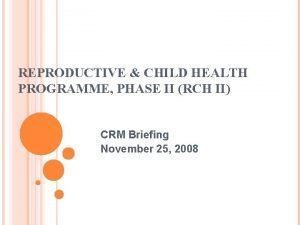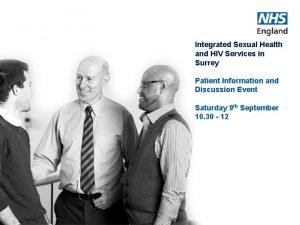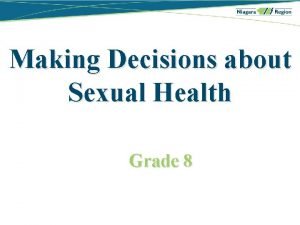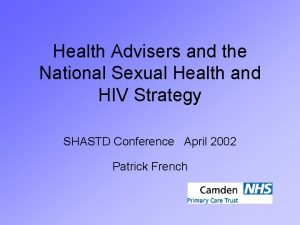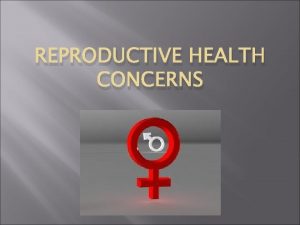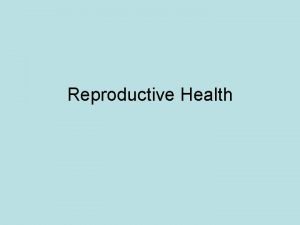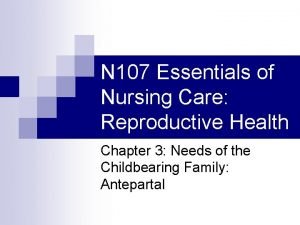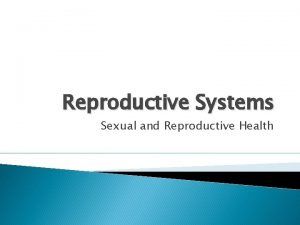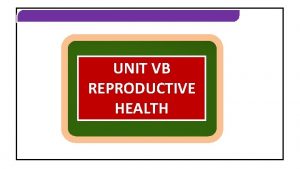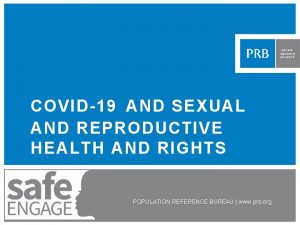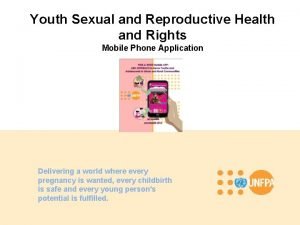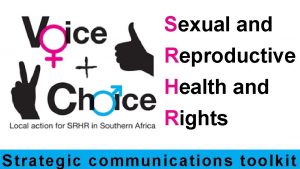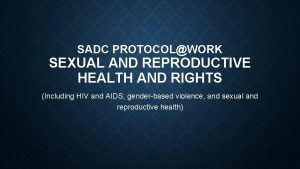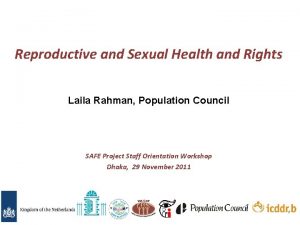Sexual and Reproductive Health and Rights in Malta





























- Slides: 29

Sexual and Reproductive Health and Rights in Malta Dr. Frances Camilleri-Cassar frances. camilleri-cassar@um. edu. mt Solidarity Overseas Services Malta Commonwealth People’s Forum 21 November 2005

Key Millennium Development Goal The Millennium Development Goals, particularly: the eradication of extreme poverty and hunger, …cannot be achieved if sexual and reproductive health and rights are not addressed.

Human Rights Reproductive and sexual rights embrace human rights that are already recognised in national laws, international human rights documents and other consensus documents.

National Policy Yet, Malta still awaits a national sexual and reproductive health policy, (although this has been on Government’s agenda for a long number of years. )

Women’s Right to Choose • Access to quality basic education reduces poverty and empowers women and girls to make their own choices. Control over one’s body is perhaps the central feminist credo. • Safe reproductive control has been central to the improvement of women’s health in Western countries. • Such control is also central to other choices such as paid work and participation in public politics.

Problematic? • However, neither the technology nor the choice are problem free. • The recipients are rarely fully informed. • Encounters with the male-dominated medical profession have made this area highly contested.

Reproductive Technology • Reproductive technology is a product of the male reality and buttresses male power over women – It takes reproductive control away from women and gives it to (mostly male) physicians – It is physically and emotionally harmful to women – It reinforces the importance of motherhood in women’s lives – It carries with it the potential for eugenic uses

Taboos • Political and religious impediments to access the necessary range of reproductive options present one of the most serious health problems facing women (and men) in Malta today. • The 2001/2002 WHO international report on young people’s health states that data for Malta on the incidence of sexual intercourse, mean age and use of contraception are unavailable. • Indeed, the survey on the sexual health of people aged 11, 13 and 15 proved problematic in Malta.

Quality Education Although the national minimum curriculum for secondary schools includes education on sex, sexuality and health …data which draws on the responses of school-aged children suggest that sex information is sporadic and largely given informally by parents or friends.

Age of First Sexual Intercourse • Mean age 21. 3 years • Median age 20 years (The First National Health Interview Survey – Summary Statistics, 2003 H. I. S. Malta)

Sexual Partner/s • • No Yes • Not applicable/No information 24% 71% 5% (The First National Health Interview Survey – Summary Statistics, 2003 H. I. S. Malta)

Young People and Contraception • Casual sex among young people has increased from 28 % in 2000 to 42% in 2004 (Carabot, 2004: 15) • Despite the high rate of casual sex, the use of condoms remains poor, with 63% indulging in unprotected sex (Carabot, 2004: 16) • Only 25% of young women use any form of consistent contraception – the OCP in 85% of cases (Carabot, 2004: 17)

Use of Contraceptives • • • Never Sometimes Rarely Frequently Always 34. 23% 13. 3% 5% 10% 7% • Not been sexually active • Not applicable/No information 15. 4% 16% (The First National Health Interview Survey – Summary Statistics, 2003 H. I. S. Malta)

Contraceptive Methods • • • Withdrawal 14% Condom 13. 3% Safe period 12% Contraceptive pill 2% Coil 0. 4% Cap/Diaphragm 0. 05% Spermicides 0. 02% Other 3. 5% N/A; No information 55% (The First National Health Interview Survey – Summary Statistics, 2003 H. I. S. Malta)

Prevention of unwanted pregnancies and abortion • Abortion is punishable at law under section 241243 A of the Criminal Code and should not be promoted as a family planning method. • Not only women but men too must bear responsibility for preventing unwanted pregnancies.

Adolescent Pregnancies • Few young women seem to worry about unplanned pregnancies. (Carabot, 2004: 17) • An increased rate of adolescent pregnancies runs parallel to the trend in unprotected sex and the lack of quality sexuality education and specific sexual and reproductive health counseling and services. (National Obstetric Information System Malta – Annual Report, 2004, Dept Health Information) • In 2004, 18% of all deliveries occurred to lone mothers…the percentage rose to 21% in the first quarter of 2005. (National Obstetric Information System Malta – First Quarterly Report: January – March 2005, Dept Health Information)

Women and Poverty • The ‘feminisation of poverty’ is intrinsically linked with female headed households as a vulnerable and residualised group. • 76% of lone parent households in Malta are headed by women. 47% are under 20 44% live below the poverty line are dependent on social benefits (HBS, 2003)

AIDS • There were 10 notified cases of AIDS and 7 deaths in Malta between 2000 and the first quarter of 2004. • Most AIDS cases seen in Malta since 1985 were homo/bisexual men. Amongst these persons, casual sex is high and the use of condoms is low (Carabot, 2004: 19)

TIME FOR ACTION Nothing just happens, it has to be planned!

TIME FOR ACTION • A key challenge to sexual and reproductive health rights is Malta’s tradition of involving religious conservative views in its national reproductive health agenda. • Young people have a right to information and prevention, and outreach services need to target ‘high risk’ groups

TIME FOR ACTION • Good access to all forms of contraception would reduce unwanted pregnancies and sexually transmitted diseases. • Malta needs to emphasis condoms as the proven best-practice preventive method for HIV/AIDS (European Policy Framework, 2004). • Reproductive control is central to women’s health and autonomy, and where services are inadequate, costs in health, life and personal freedom are enormous.

Time for Action Malta is bound to draw up a: Development Aid Policy (by 2007) …and it urgently needs to understand the state of sexual and reproductive health and rights and best practices for effective implementation of reproductive health policies.

Time for Action For example: • Malta lacks reliable data on sexual behaviour and harmonised reproductive health indicators. • Key data on the true prevalence of all STIs including HIV is unknown (Carabot, 2004). • Malta is still unsure of the prevalence of and correlation between HIV cases and drug users.

Time for Action • Sexual violence has a devastating impact on the sexuality and the reproductive health of women and teenage girls. • Yet, the Domestic Violence Act has, for years, hung in the pipeline.

Time for Action Malta urgently awaits a clear and separate policy on sexual and reproductive health. It is high time for action !


there are those… who make things happen. there are those… who watch things happen. there are those… who wondered what happened.

Which way are Maltese policy makers looking now when it matters most ?

References • Annual NOIS Report (2004) Department of Health Information, Malta. • Carabot, P. (2004) The GU Clinic Report, Department of Dermatology, Sir Paul Boffa Hospital, Malta. • Currie, C. et al. (eds) (2004) Young people’s health in context: Health Behaviour in School-Aged Children (HBSC) study: international report from the 2001/2002 survey, World Health Organization Europe. • Disease Surveillance Branch (2004) Department of Public Health, Malta. • First Quarterly NOIS Report (2005) Department of Health Information, Malta. • The First National Health Interview Survey – Summary Statistics (2003) Department of Health Information, Malta.
 Characteristics of zygomycota
Characteristics of zygomycota Basidiomycota sexual reproductive structures
Basidiomycota sexual reproductive structures Positive rights vs negative rights
Positive rights vs negative rights Conclusion of rights
Conclusion of rights Legal rights and moral rights
Legal rights and moral rights Negative right
Negative right Littoral rights.
Littoral rights. What is negative right
What is negative right Positive vs negative rights
Positive vs negative rights Positive vs negative rights
Positive vs negative rights Sexual health and relationships education scotland
Sexual health and relationships education scotland Rch in community health nursing
Rch in community health nursing Role of nurse in rch phase 2
Role of nurse in rch phase 2 Ceri evans
Ceri evans Buryfields clinic
Buryfields clinic What is sexual health
What is sexual health Sexual health
Sexual health Amy tishelman
Amy tishelman Society of sexual health advisers
Society of sexual health advisers Inguinal
Inguinal Describe reproductive health
Describe reproductive health Reproductive health definition
Reproductive health definition Height of fundus during pregnancy
Height of fundus during pregnancy Malta council for science and technology
Malta council for science and technology Bloklet
Bloklet Rmgc malta
Rmgc malta Malta zouk
Malta zouk Categorias del analisis historico
Categorias del analisis historico Malta football trials
Malta football trials Lifelong learning malta
Lifelong learning malta












